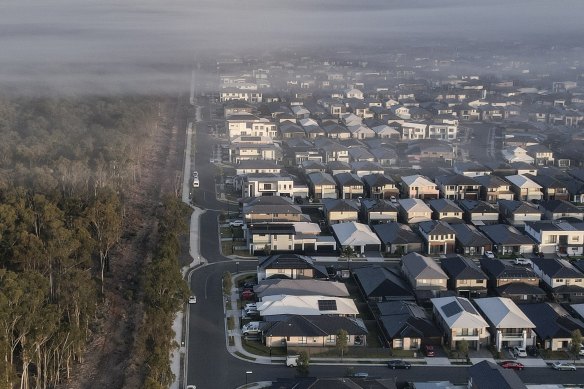Opinion
Contrary to conventional wisdom, the burbs are our great green hope
Tone Wheeler
Australian Architecture Association presidentSuburbia is unsustainable. It’s the planners’ dogma: suburbs require too much land, energy, cars and infrastructure to support too few people in oversized houses. And we are world champions: our cities have the lowest densities in the OECD.
Now, through a combination of technology and design, that idea could be turned on its head: suburbia could be the most sustainable form of urban living.

The edge of development suburbia: Marsden Park is in the Blacktown local government area, one of the regions with the greatest improvement in tree canopy.Credit: Brook Mitchell
Inklings of change are found in two recent statistics. Australia now has the highest uptake in the world of photovoltaic (PV) solar panels on roofs; and most electric vehicles are sold in our suburbs, not the city.
PV panels have a singular beauty: electrical energy is distributed by the sun, not wires. And batteries give energy independence. At a stroke, it reduces both the energy costs to the consumer and the number of poles and wires from power stations. Less dependence on fossil fuels, and fewer transmission lines in ecologically sensitive areas are good for sustainability.
The traditional downside for PVs is the large area required for panels, but large-roofed, far-scattered Aussie suburban houses are perfect. It’s easy to see why homeowners have taken to PVs with alacrity. Low installation costs can lead to big energy savings. Less to do with sustainability and climate change, more to do with economics.
The impact cannot be overestimated. Thirty per cent of suburban houses now have PVs, with 11GW of power, which is 60 per cent more than all the solar farms, and up to half the power capacity of all coal-fired power stations.
The knock-on effect of PVs is EVs. Free energy from solar panels can be used to power the battery of an electric vehicle in the garage, and a car battery can run the house during a blackout.
The key word here is garage. You might think EVs are more common in trendy inner-urban areas, but charging EVs is difficult without off-street parking, or installations in apartments or accessible public facilities. The garages of suburbia come out winners.
And suburbanites really need cars, often plural. Long distances from home to work or services have huge fuel bills at the end of them, critical to the cost of living. The preference for family cars in suburbia means sales of Tesla’s limousine-style cars are faltering, while manufacturers report increasing demand for EV SUVs.
Nevertheless, one downside of suburbia remains: the low dwelling density means too few people housed for all the infrastructure used. Hence, there’s a call for extra houses and apartments in the missing middle suburbs, fiercely resisted by councils and NIMBYs. Given the crisis, and insufficient building capacity, alternatives to building ever more homes are being sought.
Two metrics highlight some possibilities: we already have more homes (11.1 million) than households (10.4 million) and those households have 12 million unused bedrooms. Housing advocates suggest two solutions to relieve the demand, stressing occupancy, not dwellings: replacing holiday rentals with permanent occupation, and conversion of the world’s largest houses for extra occupants.
The latter idea is attractive in well-established suburbs, with heritage values, now seen as “bluefield” sites, in contrast to greenfield (never yet built on) or brownfield (former industrial) sites. Clever designs can get more people into existing homes and sites, rather than creating more and bigger buildings. This increases the population density, without disrupting the existing amenity or demanding new infrastructure.
Design ideas include alterations to carve out a separate studio within bigger homes, for rent or family use. Or additions to the house for a small, independent apartment, or a freestanding flat in the back garden. These projects can be economically attractive to families and empty nesters, and the result outdoes new builds for sustainability.
A further upside for bluefield developments is the retention of the landscape, in particular the mature trees – a double bonus as they are carbon sinks and they reduce the urban heat-island effect.
Taking resources away from building new dwellings may direct them to making better places for work and services. Big cities need multiple town centres as alternatives to a single CBD, occupied by only 15 per cent of workers. More services, schooling and employment close to home encourages active transport, walking and cycling, as less car travel is needed, even if it is by EV.
Ironically, it’s not sustainability but economy driving these decisions. However, a green upswing has started in the suburbs, not so much through concern for climate change but because renewables are more affordable. A green karma is running over the old brown dogma.
Tone Wheeler is president of the Australian Architecture Association and the design director of environa studio, which specialises in social and sustainable architecture.